Exploring the Future of Artificial Intelligence in Design Practices
VerifiedAdded on 2021/05/27
|8
|2314
|401
Essay
AI Summary
This essay delves into the future of Artificial Intelligence (AI) within the design field, examining its potential to reshape design practices and the role of designers. The study begins with a definition of key AI concepts such as algorithms, machine learning, and cognitive computing, setting the stage for an analysis of AI's current and future applications. The paper explores the methodology, focusing on a qualitative approach to understand perceptions and future trends. A literature review highlights the existing implementation of AI in various sectors, from Google Maps to commercial airlines, and the evolution of design tools. The essay then considers the impact of AI on the design industry, discussing the possibility of automation in repetitive tasks while acknowledging the irreplaceable human element in design, particularly in user interface development. The conclusion suggests a future where AI and human designers collaborate, sharing design duties, with AI handling modular design and designers focusing on user-centered design and personalization. The essay also includes a comprehensive bibliography of relevant sources.
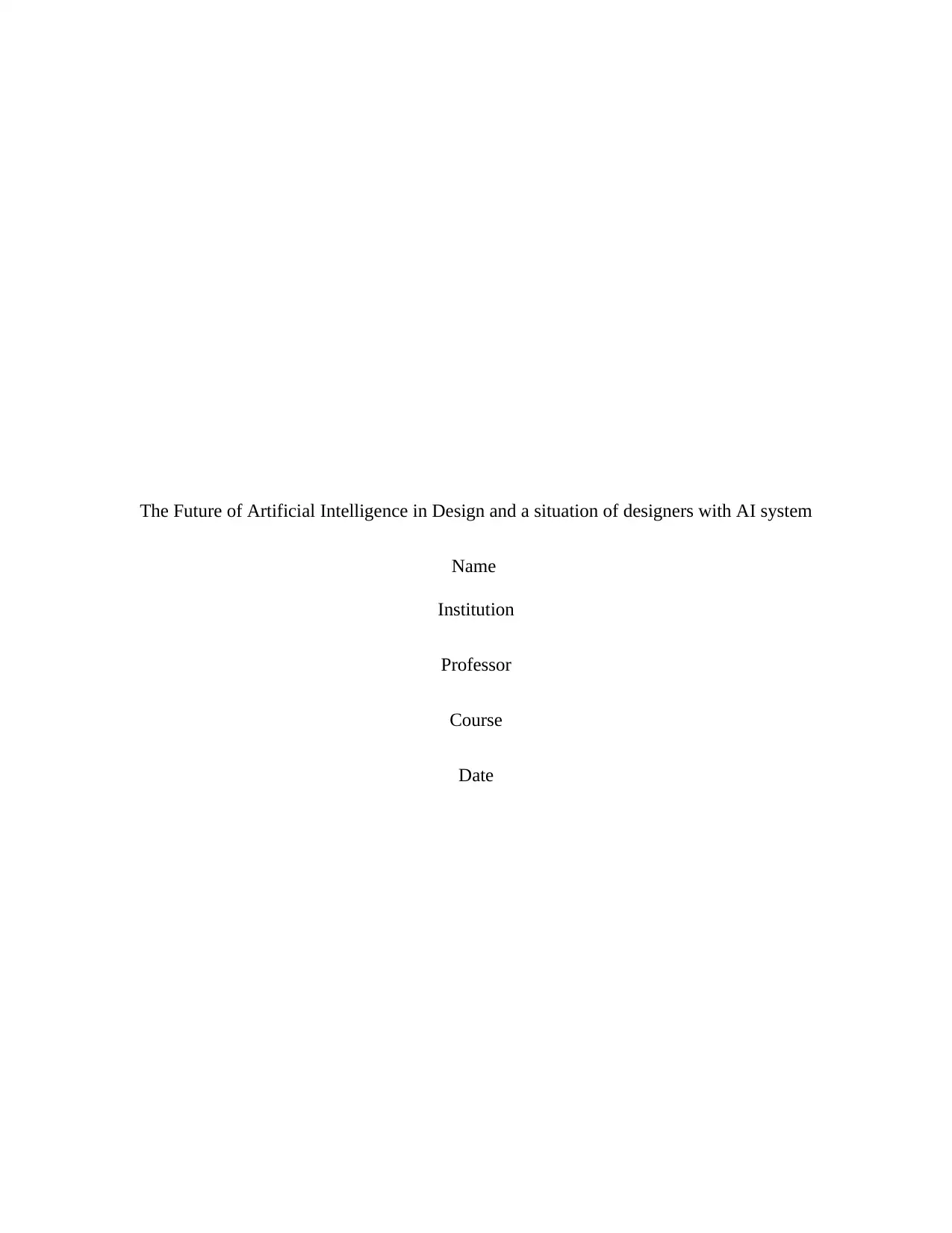
The Future of Artificial Intelligence in Design and a situation of designers with AI system
Name
Institution
Professor
Course
Date
Name
Institution
Professor
Course
Date
Paraphrase This Document
Need a fresh take? Get an instant paraphrase of this document with our AI Paraphraser
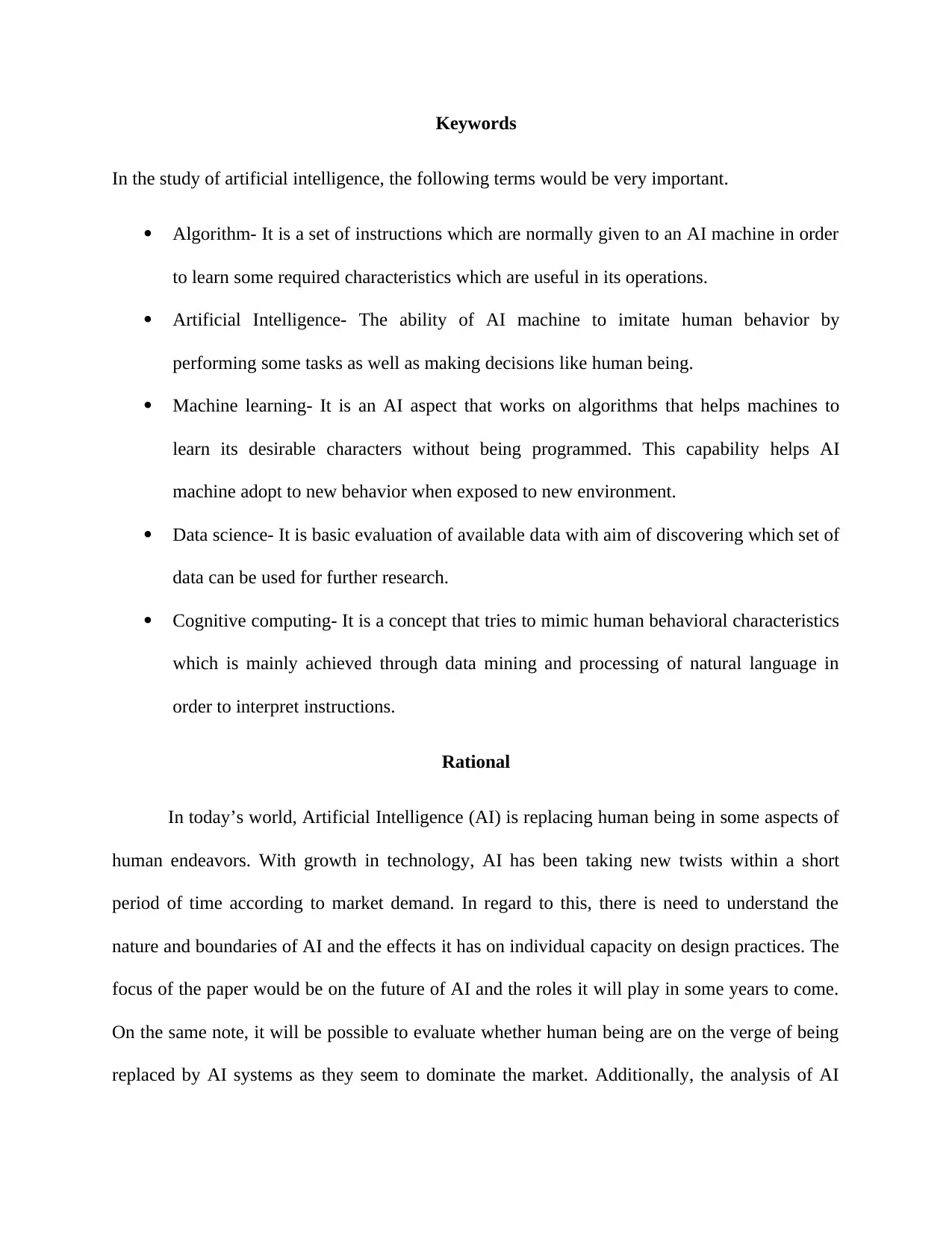
Keywords
In the study of artificial intelligence, the following terms would be very important.
Algorithm- It is a set of instructions which are normally given to an AI machine in order
to learn some required characteristics which are useful in its operations.
Artificial Intelligence- The ability of AI machine to imitate human behavior by
performing some tasks as well as making decisions like human being.
Machine learning- It is an AI aspect that works on algorithms that helps machines to
learn its desirable characters without being programmed. This capability helps AI
machine adopt to new behavior when exposed to new environment.
Data science- It is basic evaluation of available data with aim of discovering which set of
data can be used for further research.
Cognitive computing- It is a concept that tries to mimic human behavioral characteristics
which is mainly achieved through data mining and processing of natural language in
order to interpret instructions.
Rational
In today’s world, Artificial Intelligence (AI) is replacing human being in some aspects of
human endeavors. With growth in technology, AI has been taking new twists within a short
period of time according to market demand. In regard to this, there is need to understand the
nature and boundaries of AI and the effects it has on individual capacity on design practices. The
focus of the paper would be on the future of AI and the roles it will play in some years to come.
On the same note, it will be possible to evaluate whether human being are on the verge of being
replaced by AI systems as they seem to dominate the market. Additionally, the analysis of AI
In the study of artificial intelligence, the following terms would be very important.
Algorithm- It is a set of instructions which are normally given to an AI machine in order
to learn some required characteristics which are useful in its operations.
Artificial Intelligence- The ability of AI machine to imitate human behavior by
performing some tasks as well as making decisions like human being.
Machine learning- It is an AI aspect that works on algorithms that helps machines to
learn its desirable characters without being programmed. This capability helps AI
machine adopt to new behavior when exposed to new environment.
Data science- It is basic evaluation of available data with aim of discovering which set of
data can be used for further research.
Cognitive computing- It is a concept that tries to mimic human behavioral characteristics
which is mainly achieved through data mining and processing of natural language in
order to interpret instructions.
Rational
In today’s world, Artificial Intelligence (AI) is replacing human being in some aspects of
human endeavors. With growth in technology, AI has been taking new twists within a short
period of time according to market demand. In regard to this, there is need to understand the
nature and boundaries of AI and the effects it has on individual capacity on design practices. The
focus of the paper would be on the future of AI and the roles it will play in some years to come.
On the same note, it will be possible to evaluate whether human being are on the verge of being
replaced by AI systems as they seem to dominate the market. Additionally, the analysis of AI
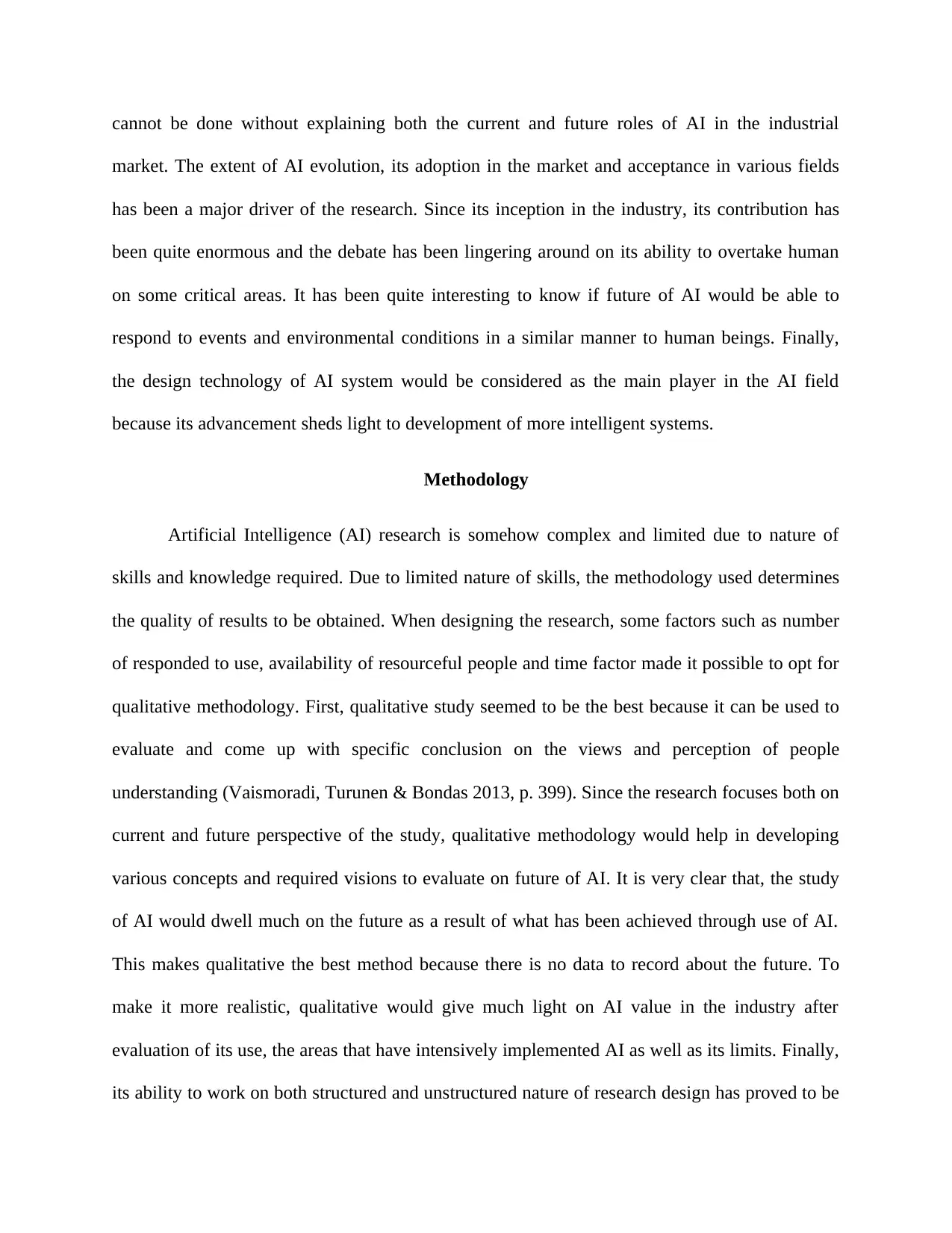
cannot be done without explaining both the current and future roles of AI in the industrial
market. The extent of AI evolution, its adoption in the market and acceptance in various fields
has been a major driver of the research. Since its inception in the industry, its contribution has
been quite enormous and the debate has been lingering around on its ability to overtake human
on some critical areas. It has been quite interesting to know if future of AI would be able to
respond to events and environmental conditions in a similar manner to human beings. Finally,
the design technology of AI system would be considered as the main player in the AI field
because its advancement sheds light to development of more intelligent systems.
Methodology
Artificial Intelligence (AI) research is somehow complex and limited due to nature of
skills and knowledge required. Due to limited nature of skills, the methodology used determines
the quality of results to be obtained. When designing the research, some factors such as number
of responded to use, availability of resourceful people and time factor made it possible to opt for
qualitative methodology. First, qualitative study seemed to be the best because it can be used to
evaluate and come up with specific conclusion on the views and perception of people
understanding (Vaismoradi, Turunen & Bondas 2013, p. 399). Since the research focuses both on
current and future perspective of the study, qualitative methodology would help in developing
various concepts and required visions to evaluate on future of AI. It is very clear that, the study
of AI would dwell much on the future as a result of what has been achieved through use of AI.
This makes qualitative the best method because there is no data to record about the future. To
make it more realistic, qualitative would give much light on AI value in the industry after
evaluation of its use, the areas that have intensively implemented AI as well as its limits. Finally,
its ability to work on both structured and unstructured nature of research design has proved to be
market. The extent of AI evolution, its adoption in the market and acceptance in various fields
has been a major driver of the research. Since its inception in the industry, its contribution has
been quite enormous and the debate has been lingering around on its ability to overtake human
on some critical areas. It has been quite interesting to know if future of AI would be able to
respond to events and environmental conditions in a similar manner to human beings. Finally,
the design technology of AI system would be considered as the main player in the AI field
because its advancement sheds light to development of more intelligent systems.
Methodology
Artificial Intelligence (AI) research is somehow complex and limited due to nature of
skills and knowledge required. Due to limited nature of skills, the methodology used determines
the quality of results to be obtained. When designing the research, some factors such as number
of responded to use, availability of resourceful people and time factor made it possible to opt for
qualitative methodology. First, qualitative study seemed to be the best because it can be used to
evaluate and come up with specific conclusion on the views and perception of people
understanding (Vaismoradi, Turunen & Bondas 2013, p. 399). Since the research focuses both on
current and future perspective of the study, qualitative methodology would help in developing
various concepts and required visions to evaluate on future of AI. It is very clear that, the study
of AI would dwell much on the future as a result of what has been achieved through use of AI.
This makes qualitative the best method because there is no data to record about the future. To
make it more realistic, qualitative would give much light on AI value in the industry after
evaluation of its use, the areas that have intensively implemented AI as well as its limits. Finally,
its ability to work on both structured and unstructured nature of research design has proved to be
⊘ This is a preview!⊘
Do you want full access?
Subscribe today to unlock all pages.

Trusted by 1+ million students worldwide
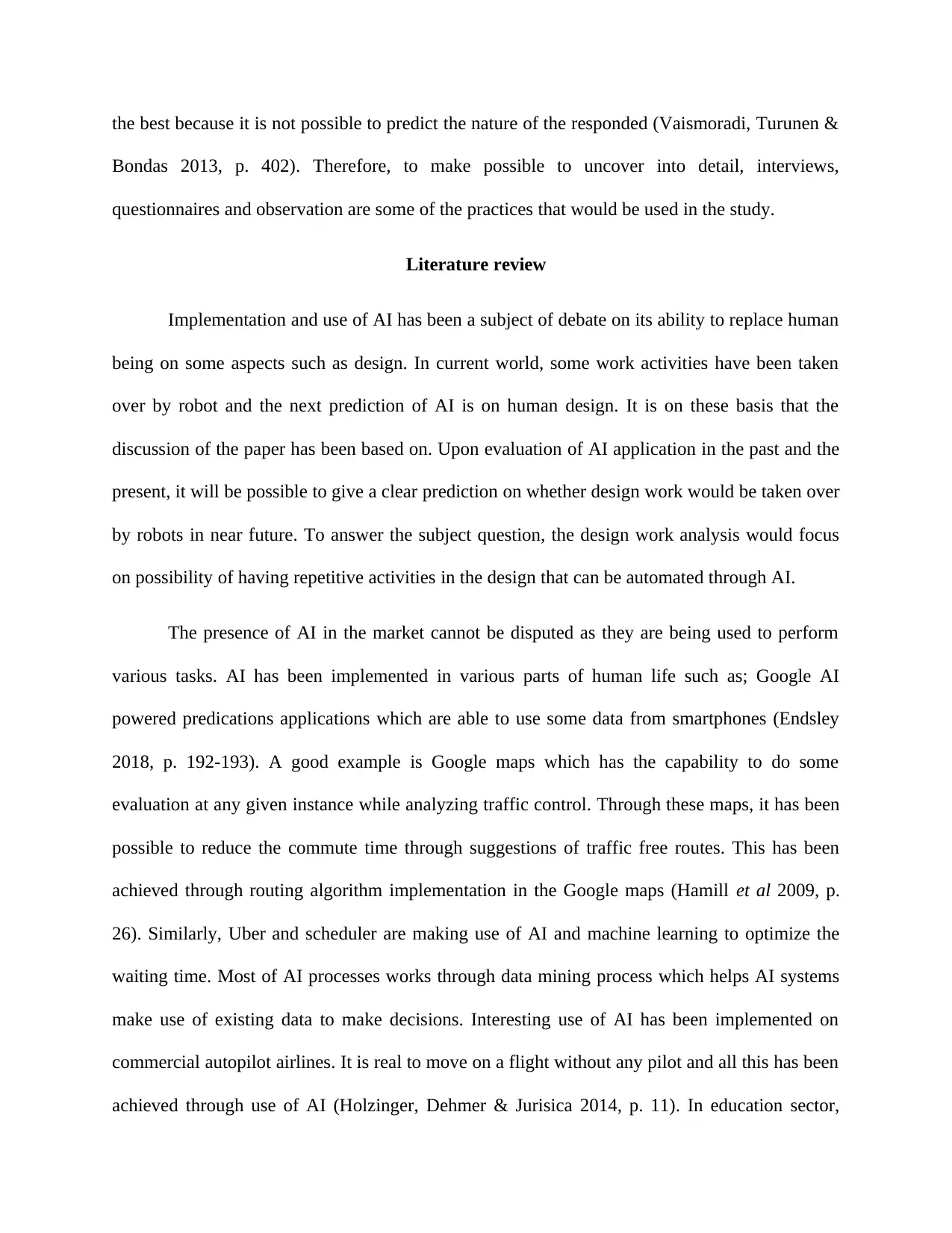
the best because it is not possible to predict the nature of the responded (Vaismoradi, Turunen &
Bondas 2013, p. 402). Therefore, to make possible to uncover into detail, interviews,
questionnaires and observation are some of the practices that would be used in the study.
Literature review
Implementation and use of AI has been a subject of debate on its ability to replace human
being on some aspects such as design. In current world, some work activities have been taken
over by robot and the next prediction of AI is on human design. It is on these basis that the
discussion of the paper has been based on. Upon evaluation of AI application in the past and the
present, it will be possible to give a clear prediction on whether design work would be taken over
by robots in near future. To answer the subject question, the design work analysis would focus
on possibility of having repetitive activities in the design that can be automated through AI.
The presence of AI in the market cannot be disputed as they are being used to perform
various tasks. AI has been implemented in various parts of human life such as; Google AI
powered predications applications which are able to use some data from smartphones (Endsley
2018, p. 192-193). A good example is Google maps which has the capability to do some
evaluation at any given instance while analyzing traffic control. Through these maps, it has been
possible to reduce the commute time through suggestions of traffic free routes. This has been
achieved through routing algorithm implementation in the Google maps (Hamill et al 2009, p.
26). Similarly, Uber and scheduler are making use of AI and machine learning to optimize the
waiting time. Most of AI processes works through data mining process which helps AI systems
make use of existing data to make decisions. Interesting use of AI has been implemented on
commercial autopilot airlines. It is real to move on a flight without any pilot and all this has been
achieved through use of AI (Holzinger, Dehmer & Jurisica 2014, p. 11). In education sector,
Bondas 2013, p. 402). Therefore, to make possible to uncover into detail, interviews,
questionnaires and observation are some of the practices that would be used in the study.
Literature review
Implementation and use of AI has been a subject of debate on its ability to replace human
being on some aspects such as design. In current world, some work activities have been taken
over by robot and the next prediction of AI is on human design. It is on these basis that the
discussion of the paper has been based on. Upon evaluation of AI application in the past and the
present, it will be possible to give a clear prediction on whether design work would be taken over
by robots in near future. To answer the subject question, the design work analysis would focus
on possibility of having repetitive activities in the design that can be automated through AI.
The presence of AI in the market cannot be disputed as they are being used to perform
various tasks. AI has been implemented in various parts of human life such as; Google AI
powered predications applications which are able to use some data from smartphones (Endsley
2018, p. 192-193). A good example is Google maps which has the capability to do some
evaluation at any given instance while analyzing traffic control. Through these maps, it has been
possible to reduce the commute time through suggestions of traffic free routes. This has been
achieved through routing algorithm implementation in the Google maps (Hamill et al 2009, p.
26). Similarly, Uber and scheduler are making use of AI and machine learning to optimize the
waiting time. Most of AI processes works through data mining process which helps AI systems
make use of existing data to make decisions. Interesting use of AI has been implemented on
commercial autopilot airlines. It is real to move on a flight without any pilot and all this has been
achieved through use of AI (Holzinger, Dehmer & Jurisica 2014, p. 11). In education sector,
Paraphrase This Document
Need a fresh take? Get an instant paraphrase of this document with our AI Paraphraser
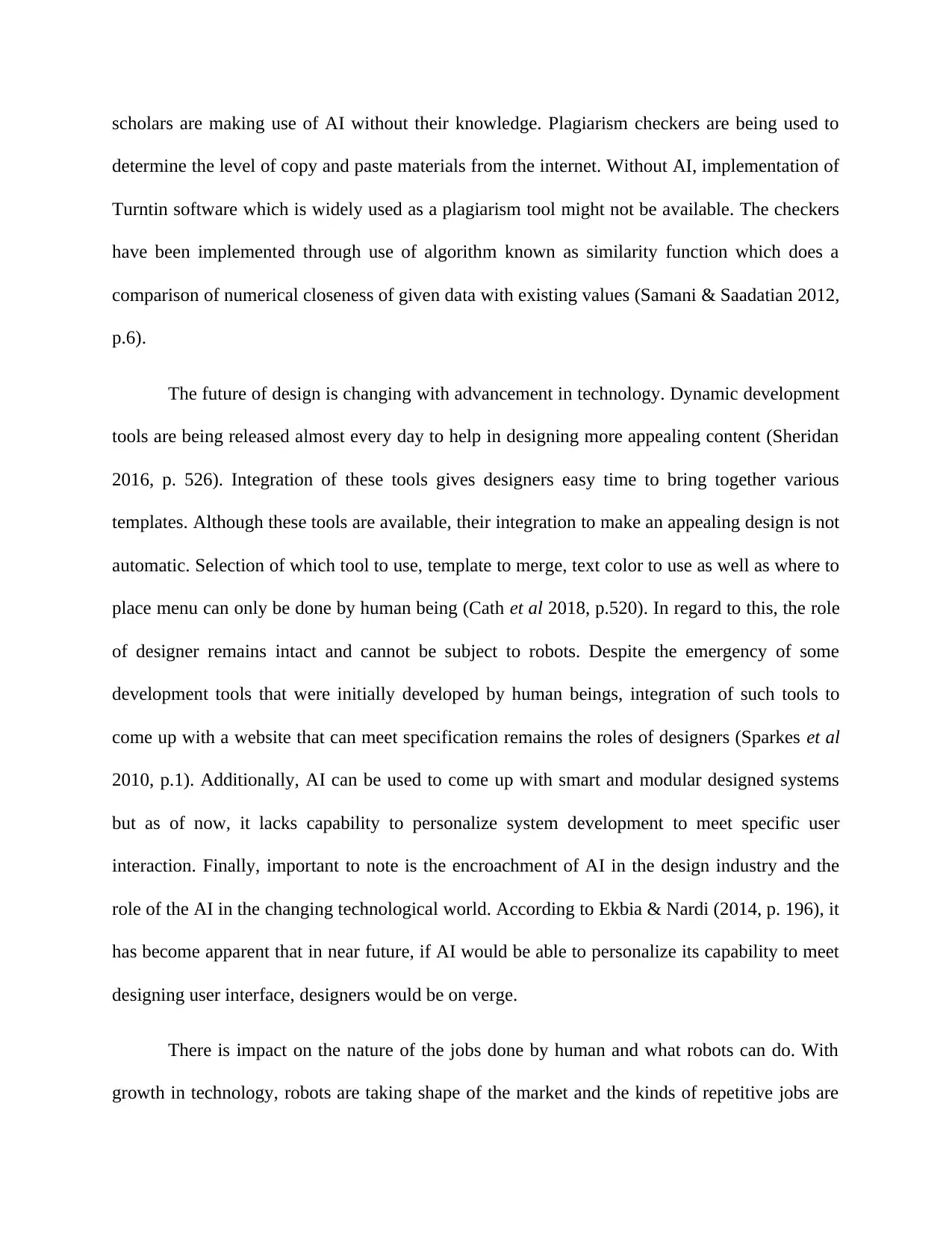
scholars are making use of AI without their knowledge. Plagiarism checkers are being used to
determine the level of copy and paste materials from the internet. Without AI, implementation of
Turntin software which is widely used as a plagiarism tool might not be available. The checkers
have been implemented through use of algorithm known as similarity function which does a
comparison of numerical closeness of given data with existing values (Samani & Saadatian 2012,
p.6).
The future of design is changing with advancement in technology. Dynamic development
tools are being released almost every day to help in designing more appealing content (Sheridan
2016, p. 526). Integration of these tools gives designers easy time to bring together various
templates. Although these tools are available, their integration to make an appealing design is not
automatic. Selection of which tool to use, template to merge, text color to use as well as where to
place menu can only be done by human being (Cath et al 2018, p.520). In regard to this, the role
of designer remains intact and cannot be subject to robots. Despite the emergency of some
development tools that were initially developed by human beings, integration of such tools to
come up with a website that can meet specification remains the roles of designers (Sparkes et al
2010, p.1). Additionally, AI can be used to come up with smart and modular designed systems
but as of now, it lacks capability to personalize system development to meet specific user
interaction. Finally, important to note is the encroachment of AI in the design industry and the
role of the AI in the changing technological world. According to Ekbia & Nardi (2014, p. 196), it
has become apparent that in near future, if AI would be able to personalize its capability to meet
designing user interface, designers would be on verge.
There is impact on the nature of the jobs done by human and what robots can do. With
growth in technology, robots are taking shape of the market and the kinds of repetitive jobs are
determine the level of copy and paste materials from the internet. Without AI, implementation of
Turntin software which is widely used as a plagiarism tool might not be available. The checkers
have been implemented through use of algorithm known as similarity function which does a
comparison of numerical closeness of given data with existing values (Samani & Saadatian 2012,
p.6).
The future of design is changing with advancement in technology. Dynamic development
tools are being released almost every day to help in designing more appealing content (Sheridan
2016, p. 526). Integration of these tools gives designers easy time to bring together various
templates. Although these tools are available, their integration to make an appealing design is not
automatic. Selection of which tool to use, template to merge, text color to use as well as where to
place menu can only be done by human being (Cath et al 2018, p.520). In regard to this, the role
of designer remains intact and cannot be subject to robots. Despite the emergency of some
development tools that were initially developed by human beings, integration of such tools to
come up with a website that can meet specification remains the roles of designers (Sparkes et al
2010, p.1). Additionally, AI can be used to come up with smart and modular designed systems
but as of now, it lacks capability to personalize system development to meet specific user
interaction. Finally, important to note is the encroachment of AI in the design industry and the
role of the AI in the changing technological world. According to Ekbia & Nardi (2014, p. 196), it
has become apparent that in near future, if AI would be able to personalize its capability to meet
designing user interface, designers would be on verge.
There is impact on the nature of the jobs done by human and what robots can do. With
growth in technology, robots are taking shape of the market and the kinds of repetitive jobs are
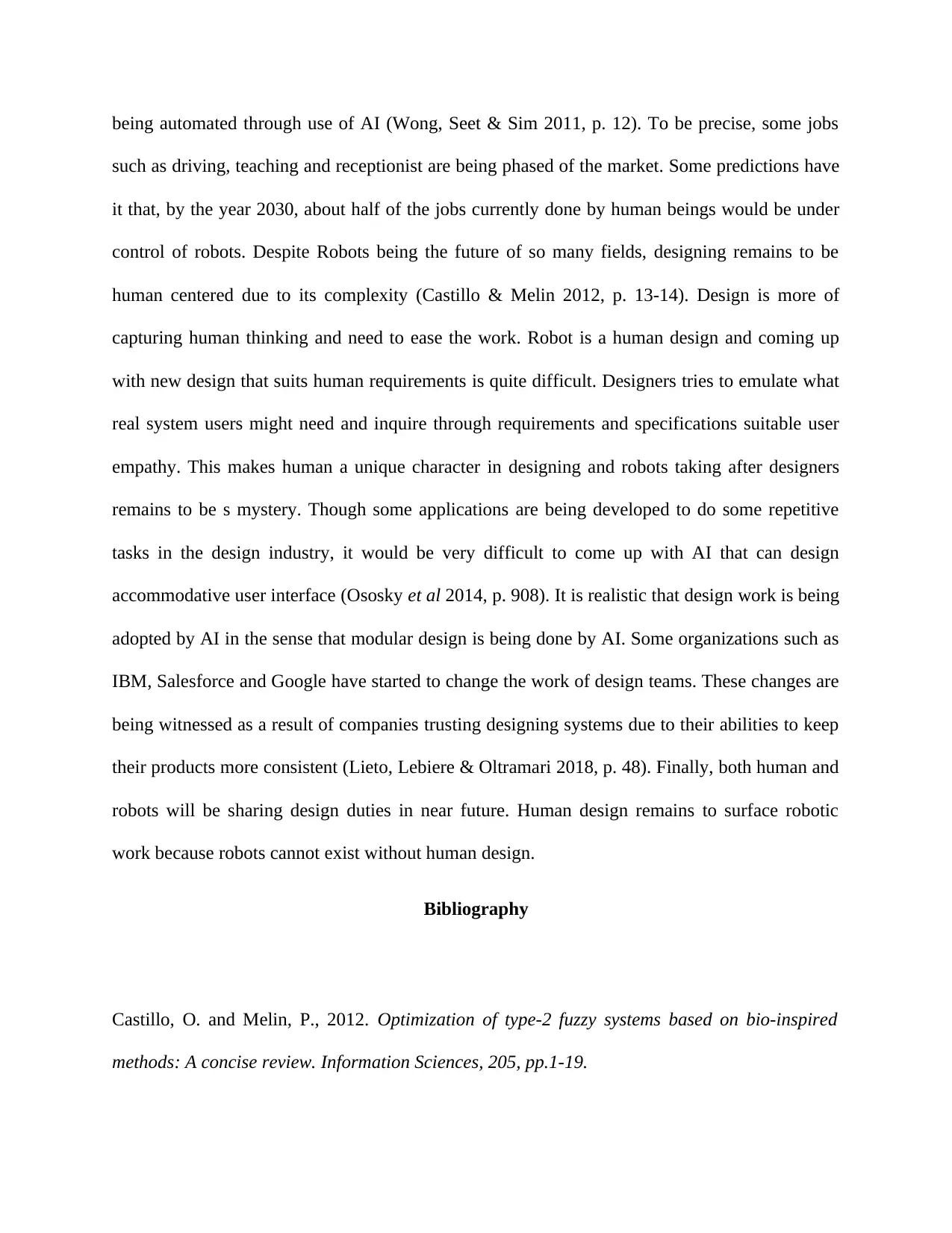
being automated through use of AI (Wong, Seet & Sim 2011, p. 12). To be precise, some jobs
such as driving, teaching and receptionist are being phased of the market. Some predictions have
it that, by the year 2030, about half of the jobs currently done by human beings would be under
control of robots. Despite Robots being the future of so many fields, designing remains to be
human centered due to its complexity (Castillo & Melin 2012, p. 13-14). Design is more of
capturing human thinking and need to ease the work. Robot is a human design and coming up
with new design that suits human requirements is quite difficult. Designers tries to emulate what
real system users might need and inquire through requirements and specifications suitable user
empathy. This makes human a unique character in designing and robots taking after designers
remains to be s mystery. Though some applications are being developed to do some repetitive
tasks in the design industry, it would be very difficult to come up with AI that can design
accommodative user interface (Ososky et al 2014, p. 908). It is realistic that design work is being
adopted by AI in the sense that modular design is being done by AI. Some organizations such as
IBM, Salesforce and Google have started to change the work of design teams. These changes are
being witnessed as a result of companies trusting designing systems due to their abilities to keep
their products more consistent (Lieto, Lebiere & Oltramari 2018, p. 48). Finally, both human and
robots will be sharing design duties in near future. Human design remains to surface robotic
work because robots cannot exist without human design.
Bibliography
Castillo, O. and Melin, P., 2012. Optimization of type-2 fuzzy systems based on bio-inspired
methods: A concise review. Information Sciences, 205, pp.1-19.
such as driving, teaching and receptionist are being phased of the market. Some predictions have
it that, by the year 2030, about half of the jobs currently done by human beings would be under
control of robots. Despite Robots being the future of so many fields, designing remains to be
human centered due to its complexity (Castillo & Melin 2012, p. 13-14). Design is more of
capturing human thinking and need to ease the work. Robot is a human design and coming up
with new design that suits human requirements is quite difficult. Designers tries to emulate what
real system users might need and inquire through requirements and specifications suitable user
empathy. This makes human a unique character in designing and robots taking after designers
remains to be s mystery. Though some applications are being developed to do some repetitive
tasks in the design industry, it would be very difficult to come up with AI that can design
accommodative user interface (Ososky et al 2014, p. 908). It is realistic that design work is being
adopted by AI in the sense that modular design is being done by AI. Some organizations such as
IBM, Salesforce and Google have started to change the work of design teams. These changes are
being witnessed as a result of companies trusting designing systems due to their abilities to keep
their products more consistent (Lieto, Lebiere & Oltramari 2018, p. 48). Finally, both human and
robots will be sharing design duties in near future. Human design remains to surface robotic
work because robots cannot exist without human design.
Bibliography
Castillo, O. and Melin, P., 2012. Optimization of type-2 fuzzy systems based on bio-inspired
methods: A concise review. Information Sciences, 205, pp.1-19.
⊘ This is a preview!⊘
Do you want full access?
Subscribe today to unlock all pages.

Trusted by 1+ million students worldwide
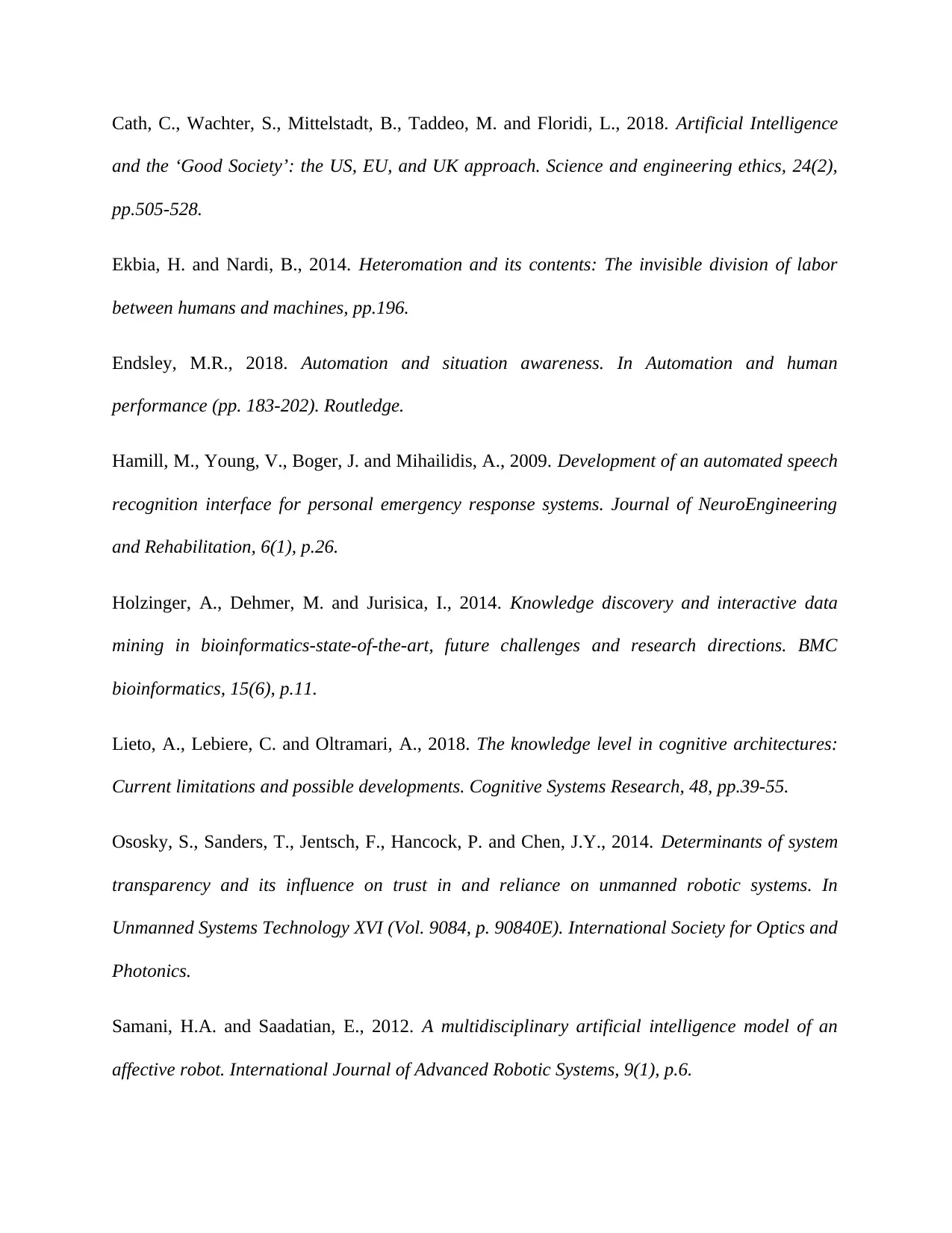
Cath, C., Wachter, S., Mittelstadt, B., Taddeo, M. and Floridi, L., 2018. Artificial Intelligence
and the ‘Good Society’: the US, EU, and UK approach. Science and engineering ethics, 24(2),
pp.505-528.
Ekbia, H. and Nardi, B., 2014. Heteromation and its contents: The invisible division of labor
between humans and machines, pp.196.
Endsley, M.R., 2018. Automation and situation awareness. In Automation and human
performance (pp. 183-202). Routledge.
Hamill, M., Young, V., Boger, J. and Mihailidis, A., 2009. Development of an automated speech
recognition interface for personal emergency response systems. Journal of NeuroEngineering
and Rehabilitation, 6(1), p.26.
Holzinger, A., Dehmer, M. and Jurisica, I., 2014. Knowledge discovery and interactive data
mining in bioinformatics-state-of-the-art, future challenges and research directions. BMC
bioinformatics, 15(6), p.11.
Lieto, A., Lebiere, C. and Oltramari, A., 2018. The knowledge level in cognitive architectures:
Current limitations and possible developments. Cognitive Systems Research, 48, pp.39-55.
Ososky, S., Sanders, T., Jentsch, F., Hancock, P. and Chen, J.Y., 2014. Determinants of system
transparency and its influence on trust in and reliance on unmanned robotic systems. In
Unmanned Systems Technology XVI (Vol. 9084, p. 90840E). International Society for Optics and
Photonics.
Samani, H.A. and Saadatian, E., 2012. A multidisciplinary artificial intelligence model of an
affective robot. International Journal of Advanced Robotic Systems, 9(1), p.6.
and the ‘Good Society’: the US, EU, and UK approach. Science and engineering ethics, 24(2),
pp.505-528.
Ekbia, H. and Nardi, B., 2014. Heteromation and its contents: The invisible division of labor
between humans and machines, pp.196.
Endsley, M.R., 2018. Automation and situation awareness. In Automation and human
performance (pp. 183-202). Routledge.
Hamill, M., Young, V., Boger, J. and Mihailidis, A., 2009. Development of an automated speech
recognition interface for personal emergency response systems. Journal of NeuroEngineering
and Rehabilitation, 6(1), p.26.
Holzinger, A., Dehmer, M. and Jurisica, I., 2014. Knowledge discovery and interactive data
mining in bioinformatics-state-of-the-art, future challenges and research directions. BMC
bioinformatics, 15(6), p.11.
Lieto, A., Lebiere, C. and Oltramari, A., 2018. The knowledge level in cognitive architectures:
Current limitations and possible developments. Cognitive Systems Research, 48, pp.39-55.
Ososky, S., Sanders, T., Jentsch, F., Hancock, P. and Chen, J.Y., 2014. Determinants of system
transparency and its influence on trust in and reliance on unmanned robotic systems. In
Unmanned Systems Technology XVI (Vol. 9084, p. 90840E). International Society for Optics and
Photonics.
Samani, H.A. and Saadatian, E., 2012. A multidisciplinary artificial intelligence model of an
affective robot. International Journal of Advanced Robotic Systems, 9(1), p.6.
Paraphrase This Document
Need a fresh take? Get an instant paraphrase of this document with our AI Paraphraser
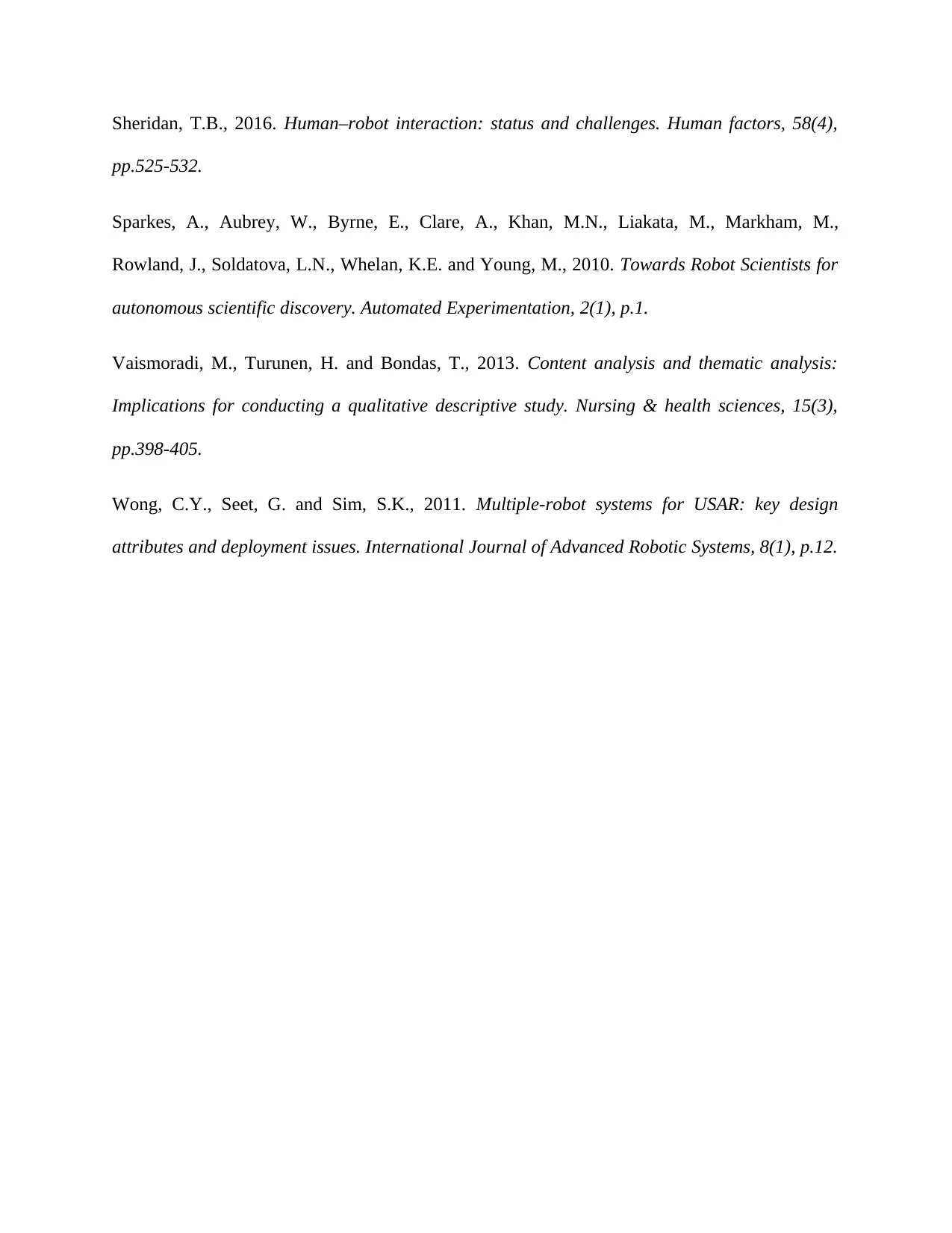
Sheridan, T.B., 2016. Human–robot interaction: status and challenges. Human factors, 58(4),
pp.525-532.
Sparkes, A., Aubrey, W., Byrne, E., Clare, A., Khan, M.N., Liakata, M., Markham, M.,
Rowland, J., Soldatova, L.N., Whelan, K.E. and Young, M., 2010. Towards Robot Scientists for
autonomous scientific discovery. Automated Experimentation, 2(1), p.1.
Vaismoradi, M., Turunen, H. and Bondas, T., 2013. Content analysis and thematic analysis:
Implications for conducting a qualitative descriptive study. Nursing & health sciences, 15(3),
pp.398-405.
Wong, C.Y., Seet, G. and Sim, S.K., 2011. Multiple-robot systems for USAR: key design
attributes and deployment issues. International Journal of Advanced Robotic Systems, 8(1), p.12.
pp.525-532.
Sparkes, A., Aubrey, W., Byrne, E., Clare, A., Khan, M.N., Liakata, M., Markham, M.,
Rowland, J., Soldatova, L.N., Whelan, K.E. and Young, M., 2010. Towards Robot Scientists for
autonomous scientific discovery. Automated Experimentation, 2(1), p.1.
Vaismoradi, M., Turunen, H. and Bondas, T., 2013. Content analysis and thematic analysis:
Implications for conducting a qualitative descriptive study. Nursing & health sciences, 15(3),
pp.398-405.
Wong, C.Y., Seet, G. and Sim, S.K., 2011. Multiple-robot systems for USAR: key design
attributes and deployment issues. International Journal of Advanced Robotic Systems, 8(1), p.12.
1 out of 8
Related Documents
Your All-in-One AI-Powered Toolkit for Academic Success.
+13062052269
info@desklib.com
Available 24*7 on WhatsApp / Email
![[object Object]](/_next/static/media/star-bottom.7253800d.svg)
Unlock your academic potential
Copyright © 2020–2025 A2Z Services. All Rights Reserved. Developed and managed by ZUCOL.




